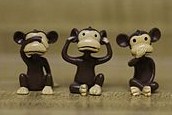Mad Andy has posted a link to a chapter in Luise White’s fascinating Speaking With Vampires: Rumor and History in Colonial Africa that deals with the apparently widespread belief amongst the African working class in C20th British East Africa that their colonial masters were engaging in vampirism and voodooism.
There’s actually a lot of illicit blood extraction about, and I think that White may be slightly overestimating the influence of capitalism (and underestimating the roles of atavism and xenophobia) in the generation of myths of this nature. Wayang is a form of popular puppet theatre in Indonesia which plays to adult audiences in a number of genres. James Siegel (Solo in the New Order, 1986) writes that
The figures of the wayang permeate Javanese thinking to the point where the puppet theater is unquestionably the richest source of metaphor and imagery in Java … The greater part of the puppeteer’s rhetoric is inaccessible to viewers; nonetheless wayang figures appear on the puppeteer’s screen, and with them language that otherwise would remain incomprehensible is embodied before the spectators.
Mrs. Draculla [sic] from Abroad is a wayang character who, since her debut, has become a powerful spirit and been responsible for at least one death. Siegel again:
Although there had already been horor (horror) stories as part of skits before that, Draculla appeared first in 1969. Since that time, her success has been so phenomenal that one cannot be sure of getting a seat on Thursday nights. Her influence has spread to the point where she has been sighted in the neighboring islands of Madura and Bali. There had been spirits in earlier comedy theaters, but they had all been Javanese. Draculla’s popularity depends on her foreignness.
Sometimes, Siegel reports, these titles are in English (Killer of Play Papa, Violent Papa), sometimes Mr Siegel has to translate them for us (Honeymoon with a Living Corpse, The Undisciplined Who Rebel, The Key to Dracula’s Desire), and some mix English with Indonesian (Metropolitan Girl, Hot Love of Kuntilanak). And, since this is what you really care about, here is his summary of the plot of the smash-hit My Wife Was the Cruel Draculla, which:
begins like almost all performances with a monologue by a servant. He is visited by his parents who wish him to marry a village girl. He refuses because he hopes to marry his boss, an extremely pretty woman. Members of the nightwatch enter and announce that youths who come to the house all disappear, that the boss’s mother is really Draculla. To test this they draw some blood from the servants. The servant is to mix it in her tea. If she drinks it, she is Draculla. Another youth enters; he has come to court the boss. The servant explains the situation to him. The mother herself comes in, drinks the tea, and proclaims it “refreshing.” The woman goes offstage and Draculla herself (played not by the woman but by the actor who specializes in the role) enters. There is a chase ending the act. The next act (all performances are in two acts) begins in a graveyard. The nightwatch is there, including a very fat man, his obese wife, and two pretty girls who ask the fat man for protection against Draculla. In a typical scene, the wife is jealous and the women do battle. They all exit except the fat man. The village head man comes in with the boss of the previous act. They plan to kill Draculla by luring her into the graveyard and then stabbing her with a wooden staff. They lie down. Draculla enters. After another chase they are caught by her; just then the sun comes up and they are saved.
Or are they? Here’s Siegel for the last time:
The Surakarta weekly Dharma Nyata for the third week of October, 1981, reported that Draculla had been sighted in Java and also in Bali. There was a racket from the room of a Japanese construction worker in a hotel. Hotel employees broke in and found him “sprawled out bathed in blood,” with two teeth marks in his neck … Before he died he gasped out his story. He had first noticed peculiar smells, particularly the odor of fish and then of perfume. Then, “it was as though someone outside was calling.” Thinking he had a guest, he opened the door. He was shocked when … what entered was a head without a body. The hair fluttered, the tongue protruded and the teeth were horrifying. The head attacked him at once mercilessly. Though the Japanese knew self-defense it was still not possible to prevent the bodyless head from latching onto his neck … “According to information received, the hotel is indeed haunted. The Hotel security guard includes magicians. They explained that no one is allowed to act in any unusual way or to curse or defecate except in certain places ….”
In her first chapter, White writes that
One of the oldest terms for vampire on the East African coast, mumiani, first appeared in Swahili dictionaries in the late nineteenth century. According to Bishop Edward Steere’s dictionary of 1870, compiled on Zanzibar, mumyani was a mummy, but could also refer to medicine. It had been a widespread belief in late nineteenth-century India, especially among plague victims on the west coast that hospitals were torture chambers designed to extract momiai, a medicine based on blood. The Indian Ocean trade, with African sailors coming and going between Zanzibar and India, could easily have carried the idea, as well as medicines supposedly made from blood, to East African markets.
Given the more or less contemporary Indonesian connection, I think that the notion of an Indian Ocean genesis would be worth pursuing – in a fire engine, of course.
Similar posts
Back soon

plese send me some detail and full information about DRACULLA WORLD.. .